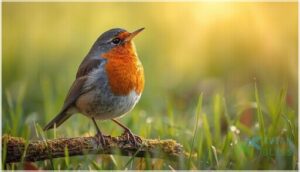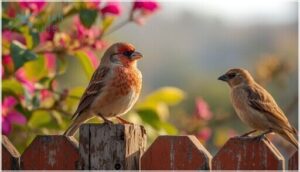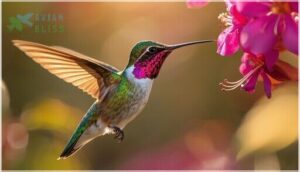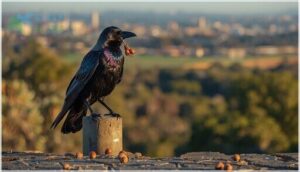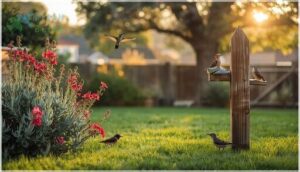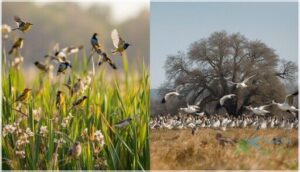This site is supported by our readers. We may earn a commission, at no cost to you, if you purchase through links.
You step outside with your morning coffee and hear a symphony you’ve never really paid attention to—chirps, trills, and calls echoing from every tree and rooftop. California hosts over 600 bird species, but you’ll encounter about two dozen regulars in your neighborhood throughout the year.
These common birds in California aren’t just background noise. They’re robins hunting for worms at dawn, hummingbirds defending feeders like tiny warriors, and crows solving puzzles that would stump most pets.
Learning to recognize them transforms your backyard into a front-row seat to nature’s daily drama, and you don’t need binoculars or a biology degree to start.
Table Of Contents
- Key Takeaways
- Most Common Birds in California
- Backyard Birds in Urban and Suburban Areas
- Birds of Prey and Waterbirds
- Seasonal and Migratory Birds
- Bird Identification Tips for California
- Frequently Asked Questions (FAQs)
- What is the most common bird in California?
- What is the small GREY bird in California?
- How do I identify a bird in my backyard?
- What is the most common backyard bird?
- How do climate changes affect California birds?
- What threats do invasive species pose to birds?
- Are there any endangered bird species in California?
- How can you participate in California bird conservation?
- What are key birdwatching etiquette tips in California?
- What threats do California birds face today?
- Conclusion
Key Takeaways
- California hosts over 600 bird species, but you’ll regularly see about two dozen common ones in your neighborhood—including American Robins, Anna’s Hummingbirds, and House Finches—that you can learn to identify without binoculars or expertise.
- You can identify backyard birds by watching their size, shape, color patterns, and behavior, or by using apps like Merlin Bird ID that recognize birds through photos and sounds with about 85% accuracy.
- California’s bird populations face serious threats from habitat loss (90% of historic wetlands are gone), climate change shifting migration patterns, and invasive species like House Sparrows that compete with native birds for nesting sites.
- Your backyard becomes a conservation tool when you add native plants, water features, and feeders—plus logging sightings in apps like eBird helps scientists track population trends across 2 billion observations.
Most Common Birds in California
If you’re new to birdwatching in California, you’ll want to start by learning the birds you’re most likely to see.
These common species show up in backyards, parks, and neighborhoods across the state. Here’s a quick look at five birds you’ll spot again and again.
American Robin Identification and Habits
You’ll recognize the American Robin by its brick-red breast and yellow bill—males show darker heads than females. These backyard birds measure 8–11 inches and hop across lawns hunting earthworms with impressive foraging adaptations.
During nesting season, territorial aggression peaks as males sing to defend their habitat. Population shifts show robins increasingly staying year-round in milder regions, with only 40% of nests producing successful fledglings.
they’re a familiar bird across North America.
House Finch Appearance and Range
House Finches thrive in California’s urban habitats, with males sporting bright red plumage on their forehead and breast—though finch diet affects color intensity, sometimes producing orange tones. Bird identification gets easier when you note males’ streaked bellies and females’ plain brown faces.
You’ll find these California birds statewide except in high mountains, with their geographic range spanning valley foothills to croplands. Winter brings finch migration declines east of the Sierra Nevada. These adaptable birds have a low continental concern.
Anna’s Hummingbird Traits and Behavior
Anna’s Hummingbird is a tiny powerhouse you’ll spot year-round across California. Males flash iridescent emerald feathers with rose-pink gorgets during courtship displays, diving from 40 meters while buzzing.
- You’ll find them defending nectar sources aggressively, chasing competitors away
- Females build spider-silk nests camouflaged with lichens, raising chicks alone
- They survive cold nights through torpor adaptation, dropping their metabolism dramatically
This territorial defense makes backyard feeders hotspots for watching California birds exhibit fascinating behavior.
California Quail Distinctive Features
California Quail stand out with their teardrop-shaped head plume curving forward like a tiny question mark. You’ll notice bold plumage patterns—males sport black-and-white facial markings with chestnut crowns, while females wear subtler brown tones. This sexual dimorphism helps with identification of birds.
Listen for their “Chi-ca-go” vocalizations echoing through chaparral and coastal scrub, where habitat adaptations let them thrive with minimal water.
American Crow Adaptability
Because American Crows rank among the most intelligent birds, they’ve mastered urban adaptation across California’s cities and farmlands. You’ll spot their habitat flexibility everywhere—from coastal regions to Central Valley parks.
Watch their foraging strategies in action: they crack nuts, use tools, and scavenge opportunistically. This corvid family behavior includes cooperative breeding, where last year’s offspring help raise new chicks, boosting survival rates.
Backyard Birds in Urban and Suburban Areas
You don’t need to travel far to spot interesting birds in California. Urban and suburban areas are home to several species that thrive around people, from backyard feeders to city parks.
Here’s a closer look at the birds you’re most likely to see right outside your door.
House Sparrow Presence and Impact
You’ve probably spotted these little brown birds hopping around parking lots and patios. House Sparrows are an invasive species that arrived in California over a century ago. While they’re everywhere in urban and suburban areas, they’re not exactly good neighbors:
- Native competition – They bully bluebirds and swallows away from nesting sites
- Early nesting habits – They claim the best spots by March
- Disease vector concerns – They carry over 25 harmful pathogens
- Urban decline – Populations dropped 22% in cities since 1995
- Control methods – Adding shrubs to your yard discourages them
These invasive bird species thrive near buildings but can harm native birds and human health.
Mourning Dove Nesting Behavior
When you watch Mourning Doves in your backyard, you’ll notice their quick nest site selection process—males suggest spots, but females choose. These bird nests are loose stick platforms, often 3 to 20 feet high.
Clutch size is usually two white eggs per brood. Incubation periods last about 14 days, with both parents sharing duties.
Predation risks from cats and hawks challenge their nesting habits throughout California’s breeding season.
Black Phoebe Urban Habitats
You’ll spot Black Phoebes thriving in California’s urban habitats, perched on fences and power lines near water. Their adaptability factors shine through territorial behavior and nest-building on building eaves using mud.
These suburban birds depend on water sources for nesting materials and insects. Population stability remains strong as they reuse nests for years, making them common urban birds across the state.
Attracting Birds to California Gardens
Want more backyard birds visiting your California garden? Think of your yard as a bird cafeteria with room service. You’ll attract the most species by offering what they need year-round:
- Native plants like California Fuchsia and Toyon provide natural food and shelter
- Water features with shallow depths under 2 inches for safe bathing
- Habitat layers from ground covers to trees, plus safe nesting spots in dense shrubs
Bird feeders with black oil sunflower seeds seal the deal.
Birds of Prey and Waterbirds
California’s skies and waterways are home to some pretty impressive birds. From hawks circling overhead to herons wading through marshes, these species play important roles in the state’s ecosystems.
Let’s look at some of the most common birds of prey and waterbirds you’re likely to spot.
Red-tailed Hawk Habitat and Diet
You’ll find Red-tailed Hawks nearly everywhere in California—from coastal valleys to mountain forests.
These raptors have impressive diet adaptations, with small mammals making up 85% of their meals. Their hunting strategies shift with the seasons, targeting more birds and reptiles when rodents are scarce.
In urban hawk habitats, they’ve even adapted nesting preferences, choosing ornamental trees and human-made structures over natural sites.
Great Horned Owl Characteristics
While hawks hunt by day, Great Horned Owls rule California’s nights with their fierce hunting behavior and unmistakable ear tufts. You’ll recognize them by their yellow eyes and impressive owl size—females weigh up to 3.7 pounds with five-foot wingspans.
Their deep territorial hoots echo through urban and wild areas alike, where population trends show they’re thriving as year-round residents.
Mallard and Other Common Ducks
Mallards dominate California’s wetland habitats with their green heads and distinctive quacks. You’ll find these ducks year-round across ponds and marshes, though breeding trends show their population bouncing back—up 49% in 2025 after hitting historic lows. Habitat loss remains their biggest threat, especially with wetlands shrinking.
Other common waterfowl you might spot include:
- Gadwall ducks with their subtle gray patterns
- Cinnamon teal sporting rusty-orange plumage
- Northern shovelers and their spoon-shaped bills
Great Blue Heron and Waterbird Species
Great Blue Herons stand nearly four feet tall in California’s wetland habitats, fishing for sculpin and bass along coastal regions. Their population has bounced back since the 1990s, with breeding colonies now showing 76-82% nesting site success. You’ll spot these majestic waterbird species alongside cormorants and egrets in wetlands—though 90% of historic marshes have vanished, threatening waterfowl identification hotspots and raising conservation migration concerns.
| Waterbird Species | Primary Diet | Foraging Range |
|---|---|---|
| Great Blue Heron | Fish (10-20cm), amphibians | Within 5 miles of nest |
| Double-crested Cormorant | Small fish, aquatic invertebrates | Coastal bays, estuaries |
| Western Grebe | Fish, crustaceans | Deep open water |
Seasonal and Migratory Birds
California’s bird population changes with the seasons. Some species stick around all year, while others only visit during specific months.
Let’s look at which birds you’ll see when, and what brings them to the Golden State.
Year-Round Resident Birds
California’s year-round resident birds offer reliable opportunities for bird identification throughout the seasons. You’ll spot American Robins, House Finches, and Anna’s Hummingbirds at your feeders any month.
These common California birds have adapted well to urban birdlife, with stable population trends showing successful habitat adaptation.
Conservation efforts in cities and natural areas support their breeding seasons, making backyard birding rewarding all year long.
Common Summer Migrants
Each spring, you’ll notice an exciting wave of songbirds arriving in California along the Pacific Flyway. Common California birds like Bullock’s Oriole, Black-headed Grosbeak, and Lazuli Bunting travel thousands of miles to breed in summer habitats across the state.
Key migratory birds to watch for:
- Allen’s Hummingbird (arrives early February)
- Vaux’s Swift (arrives early April)
- Olive-sided Flycatcher (arrives mid-April)
Migration patterns reveal that the Central Valley hosts around 65 million migrating landbirds each spring, making bird conservation efforts essential for these migrant species.
Winter Visitor Species
When winter arrives in California, you’ll spot yellow-rumped warblers flocking to Southern California gardens, trading bugs for berries.
Conservation efforts at Sacramento National Wildlife Refuge draw hundreds of thousands of ducks and geese along the Pacific Flyway.
Winter habitats like coastal wetlands support snowy egrets and brown pelicans, while monitoring programs through the Christmas Bird Count track bird diversity across these migration patterns.
Migration Patterns in California
Throughout the year, over 1 billion birds of California travel the Pacific Flyway, creating stunning migration patterns you can track from your backyard. Climate impact shifts arrival times by days each decade, while habitat restoration efforts protect critical stopover sites.
Over 1 billion birds travel California’s Pacific Flyway each year, creating migration patterns you can track from your own backyard
Bird tracking shows migratory birds peak two to three hours after sunset, with the Central Valley hosting 65 million landbirds each spring along these flyway conservation corridors.
Bird Identification Tips for California
Spotting birds in California gets easier once you know what to look for. You don’t need fancy equipment or years of experience to start identifying the birds in your neighborhood.
A few simple tips about appearance, sound, and behavior will help you figure out who’s visiting your yard or local park.
Using Size, Shape, and Color Patterns
When you’re out in the field, start by checking a bird’s silhouette recognition—its overall shape tells you a lot. Look at bill morphology next, since beak shape reveals feeding habits.
Then notice plumage variation and bird colors, from the California Towhee’s rust-brown to the gull’s gray-and-white.
Combining these bird characteristics and colors with habitat influence makes field identification much easier.
Recognizing Bird Songs and Calls
You can learn bird songs by listening for call type variations—chip notes, melodic songs, or harsh squawks. Song identification apps offer real-time bird song identification offline, comparing your recordings to extensive libraries.
Focus on acoustic feature analysis like pitch and rhythm. Bird song education resources and vocalization context clues help you recognize whether bird sounds signal alarm, territory, or contact calls.
Observing Behavior and Preferred Habitats
Watching how birds act tells you almost as much as their colors or songs. You’ll notice dominance hierarchies at feeders where California Scrub Jays push smaller birds aside. Habitat loss impact has forced many species to adapt their foraging strategies.
- Oak Titmice stick to oak woodlands, rarely wandering far
- Red-tailed Hawks use perch-and-wait hunting in open fields
- Bewick’s Wrens hide in dense brush, showing shy behavior
- Mourning Doves nest on building ledges in urban areas
- Black Phoebes perch near water, darting out for insects
Seasonal bird shifts change feeding habits and territorial aggression throughout the year.
Utilizing Bird Identification Tools and Apps
Your phone can do the heavy lifting now. Merlin Bird ID delivers around 85% app accuracy for common species through photo and sound recognition. BirdNET processes over 3,000 birds by call alone.
Feature comparison shows Merlin’s offline mode works without cell service. Each sighting you log feeds conservation impact data into eBird’s 2 billion observations, helping scientists track populations while future improvements boost backyard bird identification for everyone.
Frequently Asked Questions (FAQs)
What is the most common bird in California?
You might expect California’s most common bird to live in wild places, but the American Robin thrives in your backyard—one of nearly 199 million across the U.S.
What is the small GREY bird in California?
Several small gray birds call California home. You’ll likely spot the Bushtit, Oak Titmouse, California Gnatcatcher, or Mountain Chickadee.
Each species prefers different habitats, making Bird identification guide knowledge essential for accurate Common California bird species recognition.
How do I identify a bird in my backyard?
To identify a bird in your backyard, start by noting its size and shape, distinctive color patterns, and any unique bird sounds.
Observe its behavior and habitat clues to narrow down common California bird species using identification tools.
What is the most common backyard bird?
Ever wonder which feathered visitor claims the top spot? House Finches and American Robins tie as the most common backyard birds in California, thanks to their adaptability and year-round presence across urban and suburban habitats.
How do climate changes affect California birds?
Climate change drives range shifts and habitat destruction in California’s bird populations. Drought impact, wildfire effects, and urbanization interactions reduce reproduction success.
Bird migration patterns are changing as ecosystems struggle, making bird conservation efforts increasingly critical.
What threats do invasive species pose to birds?
Invasive species threaten birds through predation on eggs and nestlings, resource competition for nesting sites and food, and habitat alteration that destroys breeding areas.
Conservation efforts focus on habitat restoration and eradication programs.
Are there any endangered bird species in California?
California’s skies hold shadows of loss. Thirteen species carry endangered or threatened status. The California Condor and Tricolored Blackbird face steep population decline.
Habitat destruction drives urgent conservation efforts and federal listing protections.
How can you participate in California bird conservation?
You can join habitat restoration projects, contribute to citizen science programs like eBird, or help with data collection to strengthen bird conservation efforts across California.
Additionally, you can support educational outreach or engage in policy advocacy to further enhance these conservation initiatives.
What are key birdwatching etiquette tips in California?
Before you venture out, remember: respecting California bird habitats means staying on trails, keeping your distance from nests, and never using playback calls in protected areas—your quiet presence protects them.
What threats do California birds face today?
You’ll notice habitat loss hitting hardest—wetlands vanishing, climate change shifting ranges, and avian disease outbreaks spreading.
Invasive species crowd out natives while legal protections and conservation efforts work to counter these mounting threats.
Conclusion
You don’t need to travel far to see California’s wildlife. Common birds in California are already in your neighborhood, waiting for you to notice them.
Start with one species—maybe that robin on your lawn or the hummingbird buzzing past your window. Learn its call, watch its habits, and suddenly your morning coffee becomes a birdwatching session.
Your backyard isn’t boring. You just weren’t paying attention yet.
- https://www.bbc.com/future/article/20191211-crows-could-be-the-smartest-animal-other-than-primates
- https://www.youtube.com/birdwatchinghq
- https://californiabirds.org/checklist.asp
- https://ebird.org/barchart?byr=2022&eyr=2023&bmo=1&emo=12&r=US-CA
- https://www.allaboutbirds.org/guide/House_Finch/maps-range


